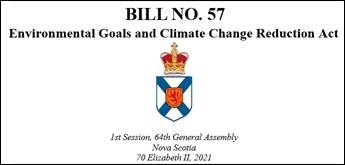Nova Scotia's emissions targets and its electricity costs
Larry Hughes, PhD
Dalhousie University

A year ago, the Provincial Legislature passed Bill 57, the Environmental Goals and Climate Change Reduction Act.
The Act's 2030 emissions reduction target requires the province to reduce its greenhouse gas emissions to at least 53% below the levels they were in 2005.
In addition, the Act has two significant emissions reduction goals for 2030. First, to have 80% of the electricity in the province supplied by renewable energy and second, to phase out coal-fired electricity generation in the province.
The underlying assumption of the goal and its targets is that both the eastern and western sides of the Atlantic Loop (from Newfoundland and Labrador and Québec, respectively) will be completed by 2030.
According to Nova Scotia Power's 2020 Integrated Resource Plan, if a source of firm power like the Atlantic Loop is completed by 2030, Nova Scotia Power will be able to both phase-out coal and reduce its emissions by over 90%.
Premier Houston is aware of this and has repeatedly called on the federal government to support the Atlantic Loop.
However, since the passage of Bill 57, two events have occurred putting Nova Scotia Power's emissions reduction targets, and Bill 57, in jeopardy.
The first is the ongoing software problems with the Labrador-Island Link. The resulting shortfall in electricity supply means that Nova Scotia Power has yet to meet its 2020 renewable energy targets.
The second is the doubling of the price of coal this year, which Nova Scotia Power still requires for the production of electricity in the province.
These events mean that Nova Scotia Power will need to raise it rates, not only for work on the Atlantic Loop, but also to cover its increased cost of energy.
In response, the Premier is reported to have said that Nova Scotia can meet its emissions reduction goals and targets using wind, solar, and hydrogen, without the Atlantic Loop.
The provincial government has also introduced Bill 212, which limits Nova Scotia Power's rate increases to only 1.8% and the cost of the energy it uses over the next two years. Consequently, Nova Scotia Power will not work on the Atlantic Loop during this time.
Despite these restrictions, low- and middle-income Nova Scotians will still be subject to significant increases in the cost of the electricity they use.
For this reason alone, the government should rethink its actions and consider alternatives.
For example, if Nova Scotia Power's domestic service tariff was redesigned as an inverted-block tariff, low-consumption consumers would pay less for their electricity than high-consumption consumers.
An inverted-block tariff typically consists of two blocks, the first block and the tail-block. The price per kilowatt-hour in the first block is less than the price in the tail-block.
The first block has a consumption limit, whereas the tail-block has none.
The electricity cost is determined by the total volume consumed. The volume up to the consumption limit is charged the lower-price and anything above the limit is charged the higher price.
If Nova Scotia Power adopted a two-block inverted tariff with a 250 kWh first-block with a rate of 10.54 cents/kWh (35% below the existing 16.215 cents/kWh) and a tail-block rate of 18.0 cents/kWh (11% higher than the existing rate), about two-thirds of Nova Scotia Power's customers would experience a decline in their monthly electricity charges.
A customer consuming 200 kWh/month would pay $11.35 less than they do now, while someone using 500 kWh/month would pay about $9.70 less.
Admittedly, large volume consumers will pay more. The two-hundred or so existing domestic service tariff customers using 5,000 kWh/month would pay approximately $71 a month more than they would with the existing domestic service tariff.
Other combinations of first-block size and block costs would produce different results. It would be up Nova Scotia Power, the UARB, and interveners to decide on what would be considered an equitable tariff.
Replacing Nova Scotia Power's existing domestic service tariff with an inverted-block tariff would let the company create meaningful price signals. The inverted-block tariff could also reduce cross-subsidies from customers with demands that are not peak-coincident to those with demands that are peak-coincident.
Electricity suppliers, such as Fortis BC, have adopted inverted block-rate tariffs because they encourage customers to reduce their electricity consumption.
If we are to meet Bill 57's 2030 emissions reduction target and goals, emissions from electricity must be reduced while ensuring that increases in the cost of electricity have limited impact on low- and middle-income Nova Scotians.
The provincial government's actions will do little to achieve either.
The government should take a step back and consider alternatives.
A new rate structure is one such alternative.
Originally published in allnovascotia.com 4 November 2022